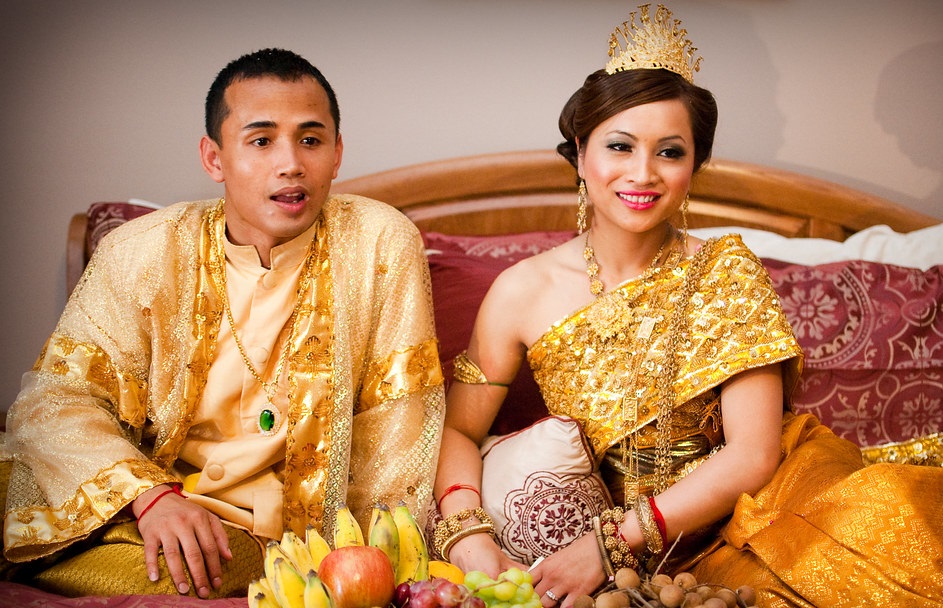The Fascinating Khmer Wedding Traditions
Written by iHeartKhmer, May 6, 2019
If you know anything about the Khmer culture, you would know that they are extremely traditional. The Khmer people are very serious, polite individuals who respect cultural traditions in every aspect of their lives. The Khmer people still practice their traditions through their food, music, dancing, daily activities, holidays, and yes, even weddings. A Khmer wedding is very elegant and much resembles and symbolizes the marriage of the first Khmer prince and in turn the legend of the birth of the land of Cambodia.

The legend says that the prince was a foreigner, exiled from his homeland, while the princess was a naga princess. On their wedding day, the father of the princess swallowed a part of the ocean, which in turn formed the land of Cambodia. This land, Cambodia, was said to be their wedding gift.
A traditional Khmer wedding is absolutely alluring and stunning in every way. Extreme detail and precision is required for each traditional aspect of the traditional Khmer wedding. A Khmer wedding can last anywhere from three days to a week. While every ceremony resembles one another, they are allowed to differ slightly depending on money, preferences, and time.
A wedding is one of the most joyous times of one’s life for a Khmer family. Typically all members of the community are invited, but most importantly family and friends of the bride and groom. Guests at the wedding are typically looking their absolute best, women with their fanciest dress, hair done up, and make up done perfectly. Guests are free to move around and come and leave as the please, it is not considered rude.
One of the best parts of a Khmer wedding is the thought and experience to which music is played all throughout the wedding ceremony. Music is constantly playing, even for weddings that last for a week. Also due to the seriousness of weddings, the music is only played by the oldest, most experienced musicians.
There are seven main elements within a traditional Khmer wedding program: groom’s processional, call to the ancestors, blessing from the monks, cleansing ceremony, honoring of the parents, passing of blessings, and the knot tying ceremony.
The groom’s processional happens on the first day. The bride waits for the groom to arrive with his processional. The groom’s processional includes all of his family and friends. The groom’s processional arrives at the bride’s parent’s house with a band of musicians in front followed by the procession and many gifts, fruits, and deserts. The bride’s family will come out to meet the procession, and then they will invite them into their home. The groom’s procession symbolizes the prince’s journey to meet the naga princess.
Next is the call to the ancestors. Within the Khmer culture family bonds are of upmost importance, so during all important events a call is made to the loved ones who have passed away. They call upon them to ask them to offer their blessings and to observe the wedding. It is very important for the Khmer culture to keep them close to our hearts and remember them in times of happiness.
Following the call to the ancestors is the blessing of the bride and groom from the Monks. Traditionally three to five monks, or in large weddings seven, will give their blessings to the couple that has specifically been chosen only for them.
The next ceremony is the cleansing ceremony. The cleansing ceremony is said to purify the bride and groom to allow them good fortune for the rest of their lives together. The devada cuts the bride’s hair and shaves the groom’s head bald, in order to throw away any misfortune. The couple is then perfumed. At the end of the ceremony the devada returns to the home of the gods. The legend says that the naga princess prayed to the devada to witness her hair being cut, and then had her locks of hair be given to her father; from this her father rejoiced in knowing that his daughter was going to be getting married.
Following the cleansing ceremony is the honoring of the parents. During this ceremony the bride and groom must honor their parents for the hardships that they endured for them while they were children. The bride holds an umbrella over the mother’s head to symbolize that the bride will not be protecting the mother. The melody Phat Cheay is traditionally playing during this ceremony.
After the parents have been honored, it is time for the blessings to be passed. In the passing of the blessing ceremony, married couples are asked to gather in a circle, while the bride and groom stand in the middle. Three candles are then lit and passed around the circle. Each person makes a sweeping motion with the candle towards the couple in order to blow the smoke from the candle in their direction. The smoke is said to protect them from all evils that could destroy their marriage. This ceremony comes to an end once the candles have been passed around the circle seven times.
The last and final ceremony is the tying of the knot ceremony. During this ceremony loved ones of the bride and groom are invited to come forward to the bride and groom and individually tie ribbons around both of their wrists. A picture is also taken so each loved one as an individual picture with the bride and groom. After the ceremony the bride and groom are required to wear the ribbons for three days to preserve the good luck.

Discuss about: The Fascinating Khmer Wedding Traditions
You must be logged in to post a comment.